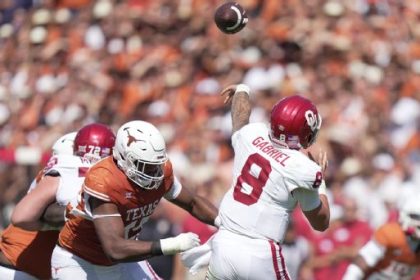Coming into this season, the main priority for the Chicago Bears was to get a full evaluation on quarterback Justin Fields and figure out if he would be the team’s franchise signal-caller going forward.
But it wasn’t the only priority.
The Bears are in year two of a rebuild after bringing in general manager Ryan Poles and head coach Matt Eberflus. For much of the season, it looked as if Chicago had remained stagnant from their 3-14 season in 2022. The offense didn’t seem to be clicking and the defense had made no tangible improvement despite Eberflus’ proclivity for that side of the ball.
The latter changed with the arrival of edge rusher Montez Sweat at the trade deadline. The team sent a second-round pick to the Commanders to acquire Sweat, who was set to become a free agent in 2024. The Bears then immediately signed him to a four-year, $98 million contract that makes him the third-highest paid defensive end by average yearly contract value.
ADVERTISEMENT
The acquisition has paid immediate dividends. Since Week 9, the Bears have fielded a top-five defense. They’ve recorded 11 sacks during that time after having just 10 in the first eight weeks of the season. They’re fifth in total yards allowed per game with 272.2 and are top 10 in points per game allowed since Sweat’s arrival.
Sweat has been the force multiplier they hoped he would be, not only getting sacks himself but opening things up all along the defensive front. Against the Lions on Sunday, defensive tackle Justin Jones had his first multi-sack game of the season.
Chicago has kept up against the run, ranking first or second all season in rushing yards allowed per game. The Bears are allowing just 83.7 yards on the ground per contest, currently behind only the San Francisco 49ers. The team has also shot up in takeaways, recording three or more in their past three games. Since Week 11, the Bears’ 11 takeaways are the most in the league despite playing only three games in that span due to their bye. The pressure and havoc their front is creating, a front that relies heavily on getting pressure with just four, is now helping out the back levels to give the offense extra chances.
Chicago has quietly built a solid roster, and the defense finally looks like it has a defensive-minded head coach.
The other side of the ball has dramatically improved since last season, too. The offensive line is no longer one of the worst in the league. It isn’t even bottom-third anymore. Chicago’s line ranks 19th in pass blocking grade, per PFF. The linemen are all finally healthy now, too, which has been evident in actually watching the games. The Bears have a top-five rushing offense thanks to Fields’ legs and a running back-by-committee approach. Thanks to the defense giving the Bears offense more chances, they rank third in the league in time of possession with an average of 31:51 per game.
Wide receiver DJ Moore, whom the team acquired in their trade out of the 2023 first overall pick with Carolina, has been stellar and ranks in the top 10 in receiving yards (1,071) and touchdowns (7) league-wide. Both of Chicago’s top wide receivers, Moore and Darnell Mooney, are averaging more than 14 yards per reception. Tight end Cole Kmet is the second-leading receiver on the team with 548 yards and five touchdowns.
The biggest question mark on the offensive side of the ball remains Fields himself.
In nine games, the third-year QB has completed 162 of 255 passing attempts for 1,810 yards and 13 touchdowns against six interceptions. Per The Athletic’s Kevin Fishbain, for the first time in Fields’ career, he has gone three consecutive games without throwing a pick. He ranks in the top 10 in touchdown percentage.
But Fields also ranks 20th in completion rate and 23rd in interception rate. His average pass length is just 7.13 yards and he benefits from the fifth-most yards after the catch gained by his receivers. He also has just a 40.4% success rate, per Pro Football Reference. In the win over the Lions on Sunday, he completed 19 of 33 pass attempts — a completion rate of 57.6% — for 223 yards and a touchdown (albeit a very impressive 41-yard touchdown pass to Moore). Fields has three games with a quarterback rating over 100, but two of the three ended up being losses.
The consistency hasn’t been there, and so the Bears have yet to make a decision on Fields’ future with the team.
There’s also the matter of the team needing to decide whether to pick up Fields’ fifth-year option this offseason. If the Bears do so, they would pay him $23.25 million, according to Over the Cap. And if they did that, a long-term contract would likely have to follow. The going rate for a franchise quarterback is around $40 million per year these days. That’s a hefty price tag for someone who hasn’t alleviated all doubts even after 36 games in the league.
[Want great stories delivered right to your inbox? Create or log in to your FOX Sports account, follow leagues, teams and players to receive a personalized newsletter daily.]
Or, the Bears could reset the clock at the quarterback position and take Carolina’s first pick, which figures to be first or second overall, and draft a quarterback. That would put a new QB under team control for five years. It also would drop a top college quarterback into a relatively good situation, where he could be immediately successful. That’s not often the case for the first or second quarterback off the board.
The Bears are rounding out their rebuild. It should be nearly complete in 2024 — and the Bears could be real contenders as soon as next season or 2025. It all hinges, as most situations in football do, on the quarterback. The rest has largely taken care of itself.
Carmen Vitali covers the NFC North for FOX Sports. Carmen had previous stops with The Draft Network and the Tampa Bay Buccaneers. She spent six seasons with the Bucs, including 2020, which added the title of Super Bowl Champion (and boat-parade participant) to her résumé. You can follow Carmen on Twitter at @CarmieV.
CHICAGO BEARS trending

Get more from Chicago Bears Follow your favorites to get information about games, news and more












